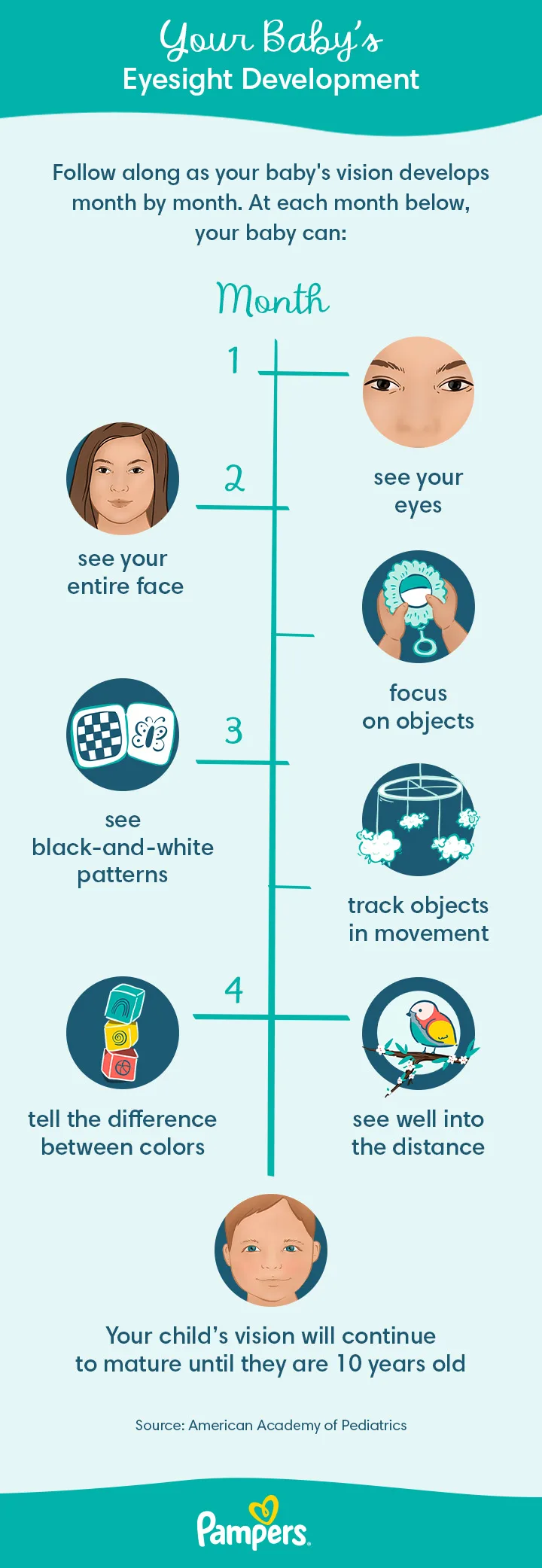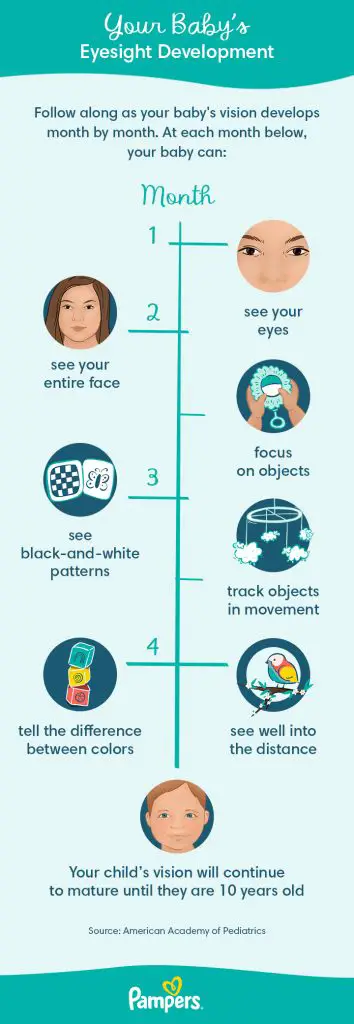Last Updated on April 12, 2023 by Francis
Introducing a baby to the world is a special moment that every parent looks forward to. But when do babies start to recognize faces and make eye contact? That is a question that every parent wants to know the answer to. This article explores the development of vision and when babies can start to see and recognize their parents’ faces.
Babies can generally see your face from the moment they are born. However, they may not be able to focus on your face until they are a few weeks old. As their eyesight develops, they will be able to focus on your face and recognize you.

Contents
When Can Babies See Your Face?
Newborns can recognize their parents’ faces within the first week of life, even though they may not be able to focus on them. At first, babies can only see objects that are 8-15 inches away from their faces. As they grow, their vision improves and they can see farther away. By the time a baby is three or four months old, they can recognize a familiar face from a distance.
Babies learn about the world using their vision, so a baby’s vision is important for their development. During their first few months, babies are learning to focus their eyes and recognize shapes and patterns. As their vision develops, they begin to recognize faces. As babies grow, they learn to differentiate between different people’s faces and are able to recognize their parents and other family members.
Babies are more likely to recognize and respond to faces with high contrast features, such as dark hair and eyes, or light hair and eyes. This helps them learn to distinguish between different faces and identify their parents. Babies may also prefer looking at faces with a smiling expression, as they are more familiar with this type of facial expression.
The First Few Weeks of Life
In the first few weeks of life, a baby’s vision is still developing and they can only focus on objects that are close to their face. At this stage, babies may be able to recognize the faces of their parents, but they may not be able to focus on them for long periods of time. Babies may also recognize faces with high contrast features and be more likely to recognize their parents’ faces.
During this period, babies may also be more likely to respond to a smiling face. Smiling faces are more familiar to babies and can help them learn to differentiate between different people’s faces.
By Three or Four Months
By the time a baby is three or four months old, their vision has improved and they can recognize a familiar face from a distance. Babies may be able to recognize their parents’ faces from across the room and turn their heads to look at them. At this age, babies may also be able to recognize other family members and familiar faces.
Babies may be more likely to respond to faces with high contrast features, such as dark hair and eyes, or light hair and eyes. Babies may also prefer looking at faces with a smiling expression, as they are more familiar with this type of facial expression.
Seeing Beyond Faces
As babies grow, they begin to recognize shapes and patterns in addition to faces. By four or five months of age, babies may be able to recognize objects and shapes from a distance. This helps them learn about the world around them and develop their vision.
Babies may also be able to recognize the sound of their parents’ voices and the sound of their own name. This helps them learn to recognize familiar people and objects and helps them develop their hearing. As babies grow, their vision and hearing continue to improve, allowing them to learn more about their environment.
Developing Visual Skills
As babies grow, their vision continues to improve and they develop the ability to focus on objects that are farther away. This helps them learn to recognize shapes and patterns, as well as people’s faces. Babies may also begin to recognize words and letters, which helps them learn to read.
Babies may begin to recognize colors and be able to distinguish between different colors. This helps them learn to identify objects and understand the world around them. As they grow, their vision continues to improve and they are able to recognize more complex shapes and patterns.
Seeing Movement
By six months of age, babies may be able to recognize people and objects from across the room and follow their movement. This helps them learn to differentiate between different people and objects and understand the world around them.
Babies may be able to recognize familiar faces and objects from a distance and may be more likely to respond to faces with high contrast features. Babies may also be more likely to respond to faces with a smiling expression, as they are more familiar with this type of facial expression.
Frequently Asked Questions
When can babies see your face?
Answer: Babies can begin to recognize faces as early as two weeks old, and can distinguish between familiar and unfamiliar faces by three months. This is because babies are born with an innate preference for facial features and their eyes can focus on close objects, so they can recognize and focus on the faces of their parents and caregivers.
How long can babies recognize faces?
Answer: Babies can recognize faces from the time they are born until they are at least one year old. Research has shown that babies can differentiate between familiar and unfamiliar faces and can recognize their parents and caregivers from as early as two weeks old. As they grow older, babies begin to recognize more faces, as well as learn to recognize people’s body language and voice.
What is the importance of facial recognition for babies?
Answer: Facial recognition is important for babies because it helps them bond with their parents and caregivers, which is essential for their emotional and social development. It also helps them understand facial expressions, which is important for communication, as well as learn to recognize people’s body language and voice. Being able to recognize people’s faces is also a key survival skill, as it helps babies differentiate between a safe person and a potential threat.
What are the different ways babies recognize faces?
Answer: Babies recognize faces in a variety of ways, including through shape and size, contrast, color, and motion. They can also recognize faces from different angles, and can distinguish between familiar and unfamiliar faces. As babies grow older, they learn to recognize more faces, as well as learn to recognize people’s body language and voice.
Are there any activities parents can do to help babies recognize faces?
Answer: Yes, there are a few activities that parents can do to help babies recognize faces. These include playing peek-a-boo, showing babies pictures of people they know, and spending time looking at each other’s faces. Parents can also use facial recognition apps, which are designed to help babies learn to recognize faces and expressions.
What happens if babies don’t recognize faces?
Answer: If babies don’t recognize faces, it can be a sign of a developmental delay or other issue. Parents should contact their doctor if their baby is not recognizing faces by the time they are three months old. It is also important for parents to spend time talking to and interacting with their baby in order to help them develop their facial recognition skills.
How your baby’s vision and sight develops
Babies’ vision develops at an astonishing rate. By the time they are three months old, they can focus on your face and recognize your voice. At six months, they can even recognize and respond to your facial expressions. Babies are special little creatures that grow and learn quickly, and seeing your face is an important step as they learn to understand the world around them.






